The Economics and Statistics Division maintains archives of previous publications for accountability purposes, but makes no updates to keep these documents current with the latest data revisions from Statistics Canada. As a result, information in older documents may not be accurate. Please exercise caution when referring to older documents. For the latest information and historical data, please contact the individual listed to the right.
<--- Return to Archive
For additional information relating to this article, please contact:
January 08, 2021LABOUR MARKET TRENDS - 2020 ANNUAL LABOUR MARKET TRENDS - 2020 ANNUAL
Following strong growth in 2019, Nova Scotia’s seasonally adjusted employment level was down by 21,400 (-4.6%) on average in 2020 due to the impacts of the COVID-19 pandemic. Labour force declined by 10,300 (-2.1%) in 2020 when compared to 2019. This pushed the annual average unemployment rate up from 7.2% in 2019 to 9.6% in 2020.
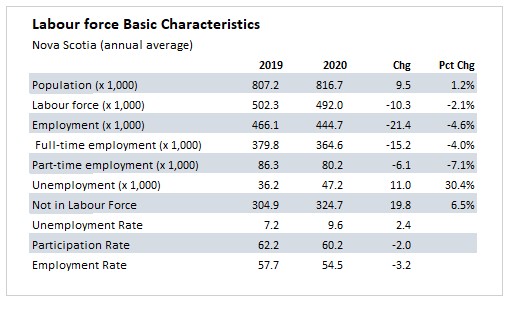
Age Cohorts
Comparing 2020 with 2019, the youth cohort (aged 15-24) saw an increase of 600 in population along with a decline in both the labour force (-5,700, -7.6%), and employment (-7,800, -11.9%). The increase in the number of unemployed (+2,100) pushed the unemployment rate for 15-24 years old up from 13.2% in 2019 to 17.3% in 2020. There was an additional 6,400 youth not in the labour force in 2020.
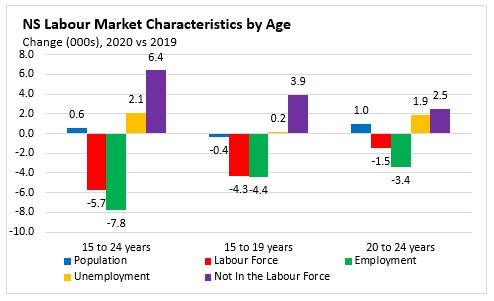
Within the 25-54 age cohort, population growth (+1,900) was accompanied by declines in both the labour force (-1,400, -0.5%) and employment (-7,400, -2.5%). The number of unemployed increased by 6,000 (+31.9%). This resulted in the unemployment rate increasing from 6.1% in 2019 to 8.0% in 2020. There was an additional 3,400 persons not in the labour force in 2020 compared to 2019.
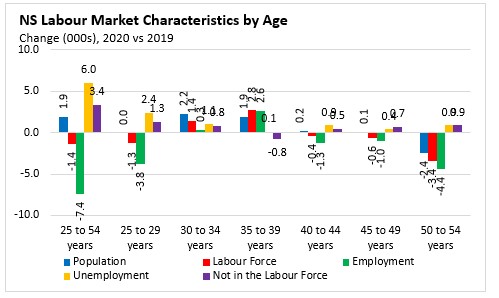
In 2020, the older cohort (aged 55+) reported an increase of 6,800 in population. However, for older workers, the labour force was down by 3,200 (-2.7%) and employment was down by 6,200 (-5.7%) from the previous year. The number of unemployed increased by 3,000 (+40.0%) pushing the unemployment rate for older workers up from 6.4% in 2019 to 9.2% in 2020.

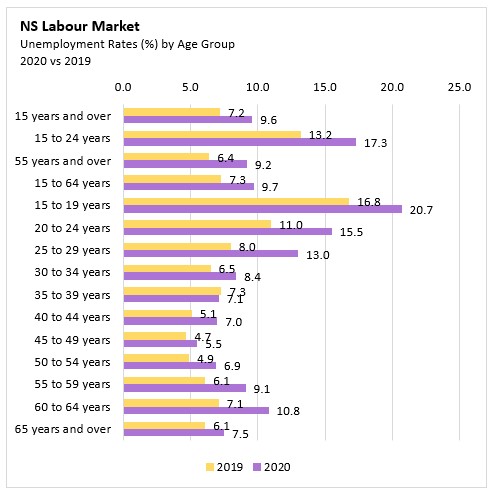
Males and Females
In 2020, Nova Scotia’s female population increased by 4,700 (+1.1%) from the previous year. With the COVID-19 pandemic, there were declines in both female labour force (-6,300, -2.6%) and female employment (-12,800, -5.5%) on average in 2020. The unemployment rate for women increased from 6.0% in 2019 to 8.8% in 2020. The female participation rate declined from 59.4% in 2019 to 57.2% in 2020 while the employment rate declined from 55.8% in 2019 to 52.2% in 2020.
Nova Scotia’s male population was up by 4,800 (+1.2%) year-over-year in 2020. The male labour force declined by 4,000 (-1.6%) in 2020 while employment among males was down by 8,500 (-3.6%) on average in 2020 when compared to 2019. With declines in employment outpacing declines in the labour force, the male unemployment rate increased from 8.4% in 2019 to 10.3% in 2020. The male participation rate was down from 65.2% in 2019 to 63.4% in 2020 while the employment rate declined from 59.8% in 2019 to 56.9% in 2020.
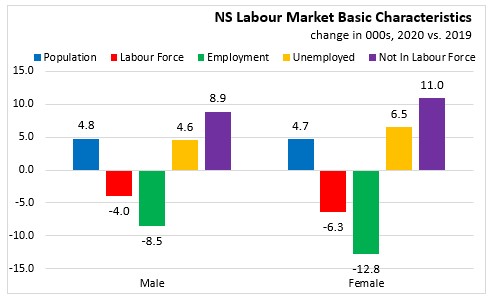
Industry and Class of Worker
Looking at the class of workers in 2020, employment declines in the private sector (-22,800, -7.7%) outweighed the increase in the public sector (+800) and the self-employed (+700). Over 2020, Nova Scotia averaged 272,100 private sector employees, 115,400 public sector employees, and 57,200 in self-employment.
Among goods-producing sectors, employment increases were reported in agriculture (+200) and utilities (+200) in 2020. Employment was down in forestry, fishing, mining, quarrying, oil and gas (-800), construction (-1,200) and manufacturing (-100).
Services-producing sector was heavily impacted by the COVID-19 pandemic and registered a decline of 19,700 in employment in 2020. Employment losses were concentrated in wholesale and retail trade (-12,500), accommodation and food services (-6,500), information, culture and recreation (-3,100) and health care and social assistance (-1,100, including daycares). There were increases in employment in professional and technical services (+2,100), finance, insurance and real estate (+1,700) and public administration (+1,200).

Regions
Comparing 2020 with 2019, Cape Breton employment was down by 2,800 while labour force declined by 2,400. The number of unemployed increased by 400 and the unemployment rate increased by 1.4 percentage points to 14.7% in 2020.
For the North Shore region, the labour force declined by 3,700 while employment was down by 5,000. With the employment decline greater than the labour force, the number of unemployed increased by 1,200. This resulted in a 2.0 percentage points increase in the unemployment rate from 7.3% to 9.3%. There was an additional 4,100 not in the labour force in 2020
The Annapolis Valley reported a decline of 4,600 in the labour force and 5,600 in employment. The number of unemployed increased by 1,000 and the number not in the labour force was up 5,000 in 2020. The unemployment rate increased by 2.3 percentage points to 8.7%.
The Southern region had a decline of 100 in the labour force and 1,200 in employment. This caused the number of unemployed to increase by 1,000. As a result, the unemployment rate increased from 8.5% in 2019 to 10.5% in 2020.
Halifax experienced an increase of 500 in the labour force even as the LFS population increased 8,700. Employment declined 6,800 in Halifax in 2020. With employment declining and the rising labour force, the number of unemployed increased by 7,300. There was an additional 8,200 persons not in the labour force. The unemployment rate in Halifax increased by 2.8 percentage points from 5.8% in 2019 to 8.6% in 2020.
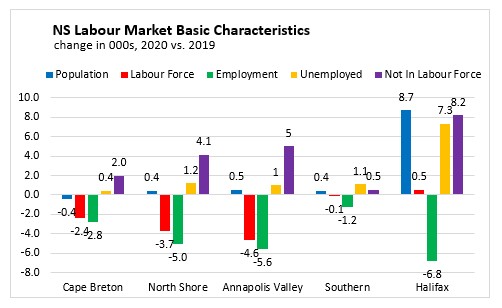
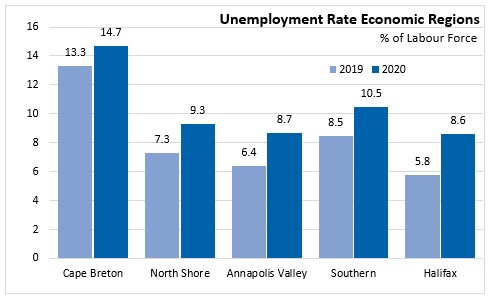
Provincial Comparisons
Both the labour force and employment declined in all provinces in 2020.
In Canada, the labour force was down 1.2% year-over-year in 2020. The largest declines in percentage terms was seen in Newfoundland and Labrador (-3.8%), Alberta (-2.6%) and Nova Scotia (-2.1%). The smallest declines were registered un New Brunswick and Manitoba, both at -0.7%.
Canada’s employment declined 5.2% in 2020. Among provinces, Alberta (-7.2%) recorded the largest decline in percentage terms followed by British Columbia (-6.2%) and Newfoundland and Labrador (-5.7%).
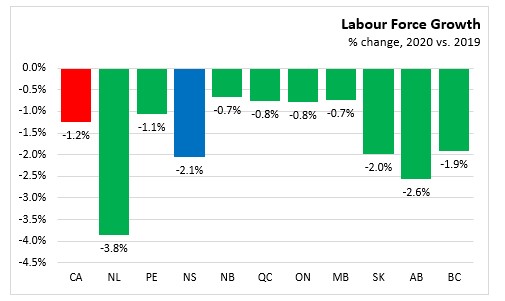

The Nova Scotia unemployment rate stood at 9.6% in 2020, slightly above the national average of 9.5%.

National Comparisons: Cities
The unemployment rate for the Halifax Census Metropolitan Area (CMA) was 8.6% in 2020 up from 5.8% in 2019. The unemployment rate was up across all CMAs in 2020 with Calgary and Edmonton reporting the highest unemployment rate at 11.8% in 2020. The lowest unemployment rate was registered un Quebec City (6.6%).

The employment rate for the Halifax CMA was 61.1% in 2020, down 3.3 percentage points from 64.4% in 2019. In 2020, Peterborough, Ontario (47.7%) had the lowest employment rate while Barrie, Ontario (65.3%) had the highest.
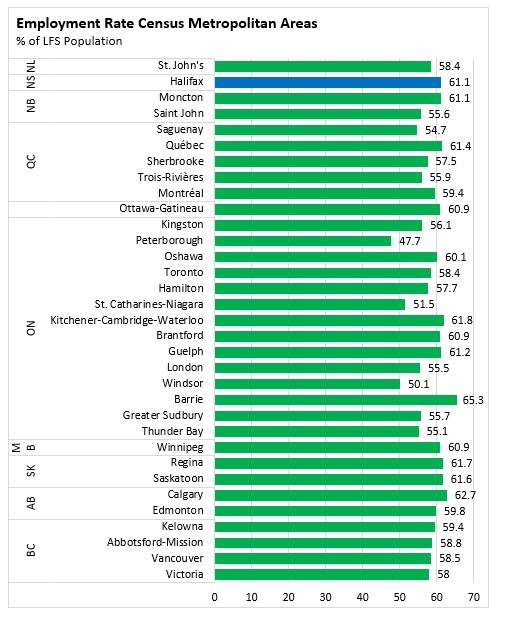
Halifax’s employment declined 2.8% in 2020. Employment declined across all CMAs except for Moncton (+0.1%), London (+0.5%) and Barrie (+0.5%) in 2020. The largest decline in percentage terms was registered in Peterborough, Ontario (-15.1%).
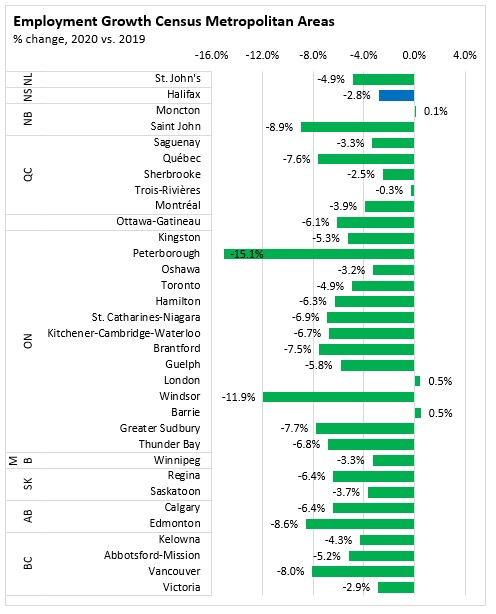
Sources:
Statistics Canada. Table 14-10-0327-01 Labour force characteristics by sex and detailed age group, annual
Statistics Canada. Table 14-10-0096-01 Labour force characteristics by census metropolitan area, annual
Statistics Canada. Table 14-10-0090-01 Labour force characteristics by province, territory and economic region, annual
Statistics Canada. Table 14-10-0023-01 Labour force characteristics by industry, annual (x 1,000)
Statistics Canada. Table 14-10-0027-01 Employment by class of worker, annual (x 1,000)
<--- Return to Archive